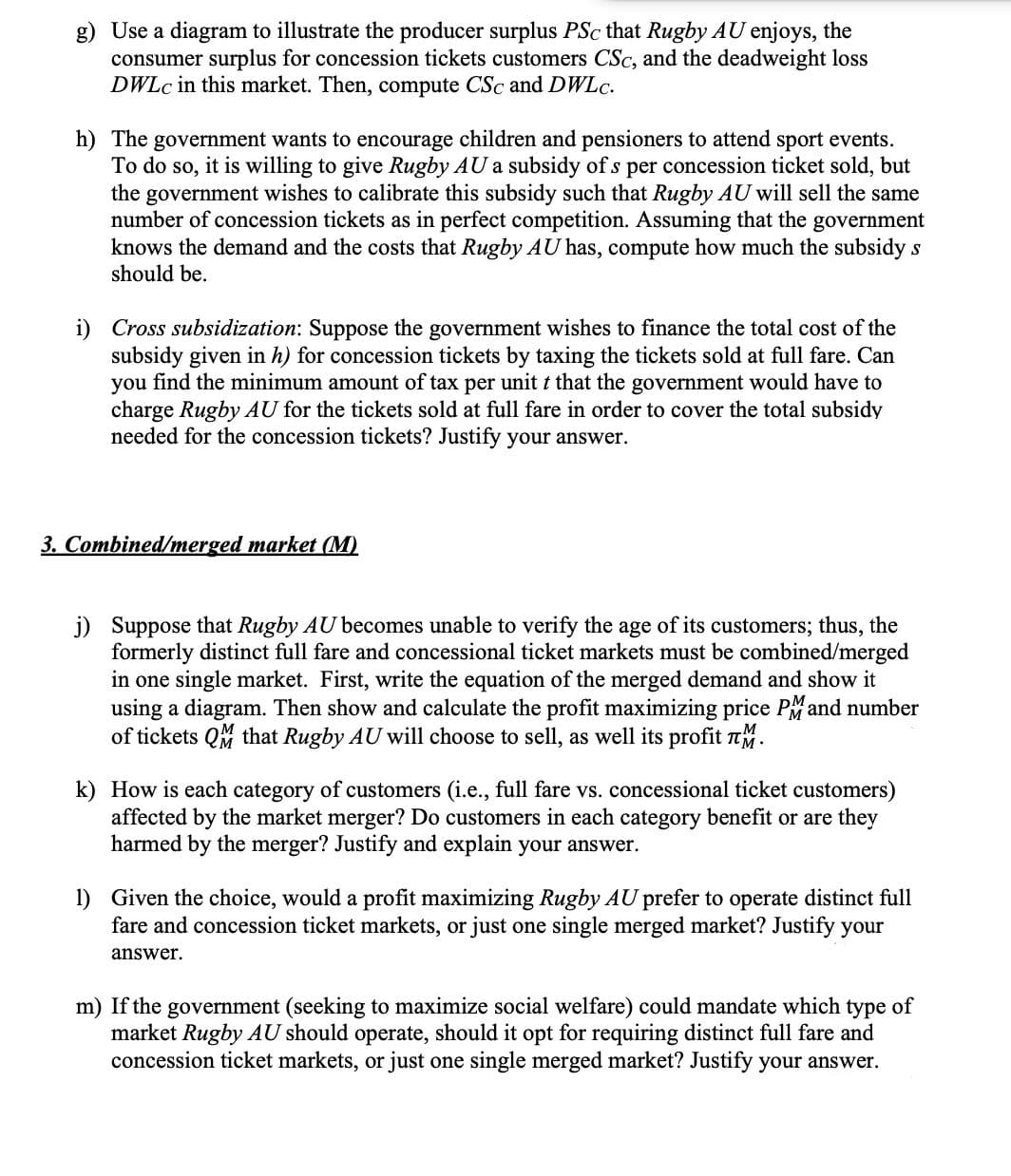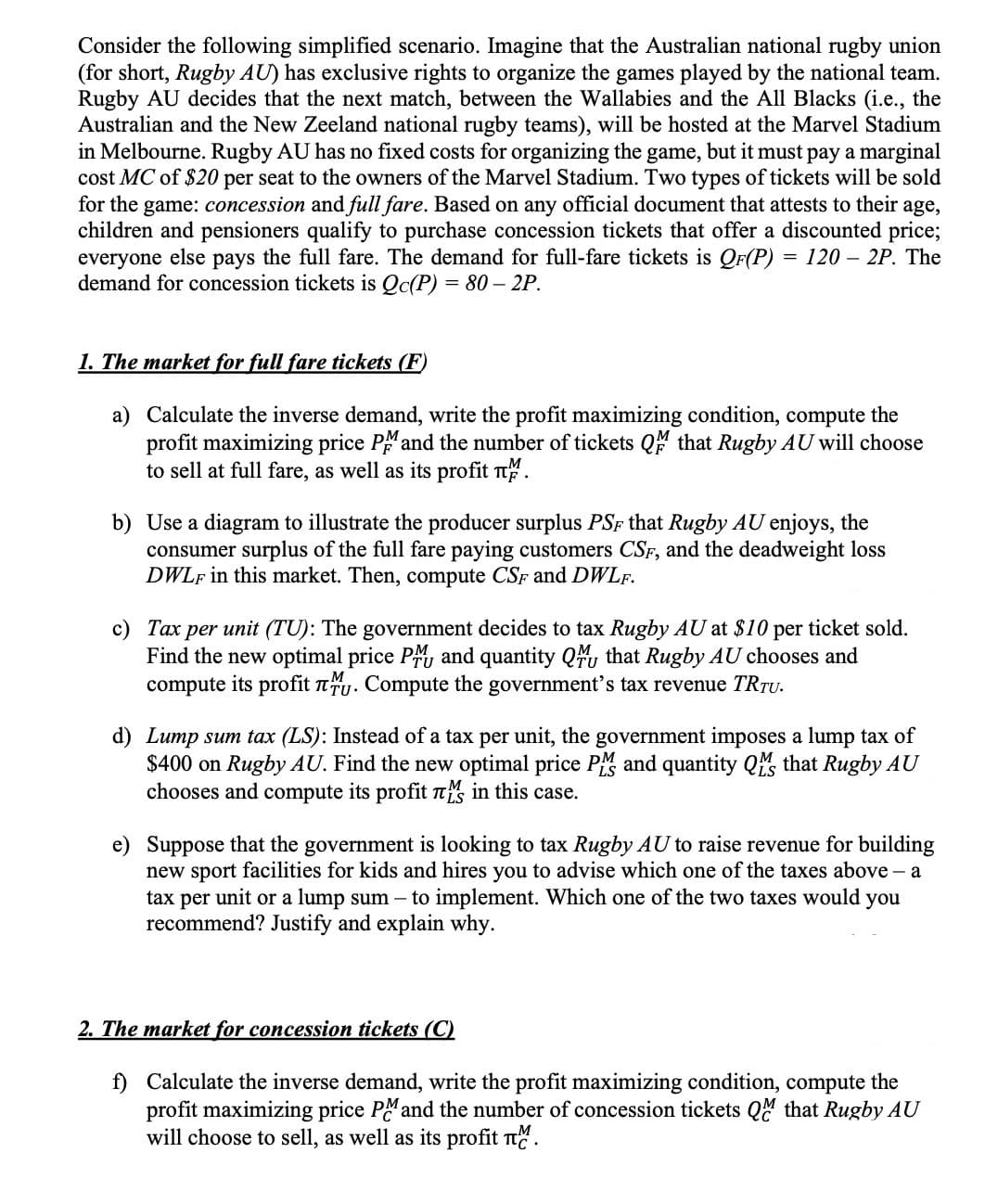Consider the following simplified scenario. Imagine that the Australian national rugby union (for short, Rugby AU) has exclusive rights to organize the games played by the national team. Rugby AU decides that the next match, between the Wallabies and the All Blacks (i.e., the Australian and the New Zeeland national rugby teams), will be hosted at the Marvel Stadium in Melbourne. Rugby AU has no fixed costs for organizing the game, but it must pay a marginal cost MC of $20 per seat to the owners of the Marvel Stadium. Two types of tickets will be sold for the game: concession and full fare. Based on any official document that attests to their age, children and pensioners qualify to purchase concession tickets that offer a discounted price; everyone else pays the full fare. The demand for full-fare tickets is QF(P) = 120- 2P. The demand for concession tickets is Qc(P) = 80-2P.
Consider the following simplified scenario. Imagine that the Australian national rugby union (for short, Rugby AU) has exclusive rights to organize the games played by the national team. Rugby AU decides that the next match, between the Wallabies and the All Blacks (i.e., the Australian and the New Zeeland national rugby teams), will be hosted at the Marvel Stadium in Melbourne. Rugby AU has no fixed costs for organizing the game, but it must pay a marginal cost MC of $20 per seat to the owners of the Marvel Stadium. Two types of tickets will be sold for the game: concession and full fare. Based on any official document that attests to their age, children and pensioners qualify to purchase concession tickets that offer a discounted price; everyone else pays the full fare. The demand for full-fare tickets is QF(P) = 120- 2P. The demand for concession tickets is Qc(P) = 80-2P.
Chapter14: Monopoly
Section: Chapter Questions
Problem 14.8P
Related questions
Question
part G H I

Transcribed Image Text:g) Use a diagram to illustrate the producer surplus PSc that Rugby AU enjoys, the
consumer surplus for concession tickets customers CSc, and the deadweight loss
DWLc in this market. Then, compute CSc and DWLc.
h) The government wants to encourage children and pensioners to attend sport events.
To do so, it is willing to give Rugby AU a subsidy of s per concession ticket sold, but
the government wishes to calibrate this subsidy such that Rugby AU will sell the same
number of concession tickets as in perfect competition. Assuming that the government
knows the demand and the costs that Rugby AU has, compute how much the subsidy s
should be.
i) Cross subsidization: Suppose the government wishes to finance the total cost of the
subsidy given in h) for concession tickets by taxing the tickets sold at full fare. Can
you find the minimum amount of tax per unit t that the government would have to
charge Rugby AU for the tickets sold at full fare in order to cover the total subsidy
needed for the concession tickets? Justify your answer.
3. Combined/merged market (M)
j) Suppose that Rugby AU becomes unable to verify the age of its customers; thus, the
formerly distinct full fare and concessional ticket markets must be combined/merged
in one single market. First, write the equation of the merged demand and show it
using a diagram. Then show and calculate the profit maximizing price PM and number
of tickets QM that Rugby AU will choose to sell, as well its profit M.
k) How is each category of customers (i.e., full fare vs. concessional ticket customers)
affected by the market merger? Do customers in each category benefit or are they
harmed by the merger? Justify and explain your answer.
1) Given the choice, would a profit maximizing Rugby AU prefer to operate distinct full
fare and concession ticket markets, or just one single merged market? Justify your
answer.
m) If the government (seeking to maximize social welfare) could mandate which type of
market Rugby AU should operate, should it opt for requiring distinct full fare and
concession ticket markets, or just one single merged market? Justify your answer.

Transcribed Image Text:Consider the following simplified scenario. Imagine that the Australian national rugby union
(for short, Rugby AU) has exclusive rights to organize the games played by the national team.
Rugby AU decides that the next match, between the Wallabies and the All Blacks (i.e., the
Australian and the New Zeeland national rugby teams), will be hosted at the Marvel Stadium
in Melbourne. Rugby AU has no fixed costs for organizing the game, but it must pay a marginal
cost MC of $20 per seat to the owners of the Marvel Stadium. Two types of tickets will be sold
for the game: concession and full fare. Based on any official document that attests to their age,
children and pensioners qualify to purchase concession tickets that offer a discounted price;
everyone else pays the full fare. The demand for full-fare tickets is QF(P) = 120- 2P. The
demand for concession tickets is Qc(P) = 80-2P.
1. The market for full fare tickets (F)
a)
Calculate the inverse demand, write the profit maximizing condition, compute the
profit maximizing price PM and the number of tickets QM that Rugby AU will choose
to sell at full fare, as well as its profit .
b) Use a diagram to illustrate the producer surplus PSF that Rugby AU enjoys, the
consumer surplus of the full fare paying customers CSF, and the deadweight loss
DWLF in this market. Then, compute CSF and DWLF.
c) Tax per unit (TU): The government decides to tax Rugby AU at $10 per ticket sold.
Find the new optimal price PM and quantity Q that Rugby AU chooses and
compute its profit . Compute the government's tax revenue TRTU.
d) Lump sum tax (LS): Instead of a tax per unit, the government imposes a lump tax of
$400 on Rugby AU. Find the new optimal price PM and quantity Q that Rugby AU
chooses and compute its profit in this case.
e) Suppose that the government is looking to tax Rugby AU to raise revenue for building
new sport facilities for kids and hires you to advise which one of the taxes above - a
tax per unit or a lump sum - to implement. Which one of the two taxes would you
recommend? Justify and explain why.
2. The market for concession tickets (C)
f) Calculate the inverse demand, write the profit maximizing condition, compute the
profit maximizing price PM and the number of concession tickets QM that Rugby AU
will choose to sell, as well as its profit M.
Expert Solution
This question has been solved!
Explore an expertly crafted, step-by-step solution for a thorough understanding of key concepts.
Step by step
Solved in 5 steps with 4 images

Knowledge Booster
Learn more about
Need a deep-dive on the concept behind this application? Look no further. Learn more about this topic, economics and related others by exploring similar questions and additional content below.Recommended textbooks for you


Exploring Economics
Economics
ISBN:
9781544336329
Author:
Robert L. Sexton
Publisher:
SAGE Publications, Inc

Principles of Economics (MindTap Course List)
Economics
ISBN:
9781305585126
Author:
N. Gregory Mankiw
Publisher:
Cengage Learning


Exploring Economics
Economics
ISBN:
9781544336329
Author:
Robert L. Sexton
Publisher:
SAGE Publications, Inc

Principles of Economics (MindTap Course List)
Economics
ISBN:
9781305585126
Author:
N. Gregory Mankiw
Publisher:
Cengage Learning

Essentials of Economics (MindTap Course List)
Economics
ISBN:
9781337091992
Author:
N. Gregory Mankiw
Publisher:
Cengage Learning

Principles of Microeconomics (MindTap Course List)
Economics
ISBN:
9781305971493
Author:
N. Gregory Mankiw
Publisher:
Cengage Learning

Principles of Macroeconomics (MindTap Course List)
Economics
ISBN:
9781285165912
Author:
N. Gregory Mankiw
Publisher:
Cengage Learning